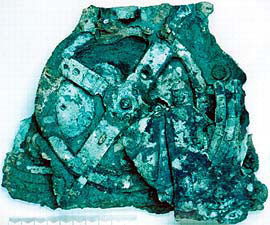
 |
News on the Antikythera Mechanism Have you ever heard the term “antikythera mechanism” but have not really been sure what it was? It is a Greek invention that was used to calculate astronomical positions. Scientists believe it was created around 80 BC, but it was not discovered until 1902. A Greek diver by the name of Elias Stadiatos found a wrecked Roman cargo ship off the coast of the Antikythera Island in 1900, but he had no idea of the treasure it contained. It was not until 1902 that archaeologist Valerios Stais found the antikythera mechanism. At first, he thought it was a rock with a gear wheel, but upon closer inspection saw that it was some sort of mechanism that was encrusted and corroded.  What he had discovered was one of the world’s oldest geared mechanisms. As the antikythera mechanism was studied, scientists found text on it. They were able to decipher almost 100% of the text, but that translation has never been published. After years and years of careful cleaning, it was British science historian Derek J. de Solla Price who developed the theory that it had been used to calculate the motions of the stars and planets. What Stais had found in the wreckage was the world’s first analog computer. How did the Greek antikythera mechanism get on a Roman ship? No one knows quite for sure, but there is a theory that it was made on the Greek island of Rhodes as it was known as a center of astronomy and mechanical engineering during this period. Archaeologists think that perhaps it was looted from the island by the Romans and was being shipped to Rome to Julius Caesar when the shipwreck occurred. How was the antikythera mechanism used? Price himself attempted to reconstruct the mechanism to see how it worked. He theorized that its owner would rotate a shaft that had originally been contained in a wooden box (that had since disintegrated). The owner could then read the dials and determine the progressions of both the lunar months and synodic months (the period between consecutive new moons) over four year cycles. The front dial showed the progression of the Sun and Moon through the zodiac. The rear had two dials – one upper and one lower. The upper dial shows a four-year period. The lower dial was designed to plot a solitary synodic month while an accompanying dial shows the entire lunar year of twelve synodic months. Allan George Bromley, an Australian computer scientist, along with Michael Wright, built another reconstruction in 2002. Wright built a reconstruction based not on Price’s original model, but by using better X-ray images taken by Bromley. They believe that the arrangements Price came up with was not entirely accurate. Bromley and Wright believe both back dials have different functions and also that there was a mechanism under the front dial that was lost. This model alludes to the fact that the antikythera mechanism was actually an orrery, a device mentioned in ancient literature that showed the positions of the heavenly bodies using a large clockwork mechanism. The antikythera mechanism is currently being studied by scientists from Cardiff University, the National and Kapodistrian University of Athens, the Aristotle University of Thessaloniki, the National Archaeological Museum of Athens, X-Tek Systems UK, and Hewlett-Packard as part of the Antikythera Mechanism Research Project. The antikythera mechanism and a reconstruction currently reside at the National Archaeological Museum of Athens. There is a reconstructed model at the American Computer Museum in Montana. |
What is the Antikythera Mechanism?  History of the Antikythera Mechanism
History of the Antikythera Mechanism News on the Antikythera Mechanism
News on the Antikythera Mechanism Experts on the Antikythera Mechanism
Experts on the Antikythera Mechanism
|
� 2006 Antikythera Mechanism |